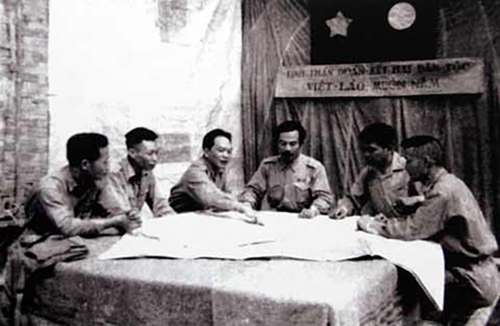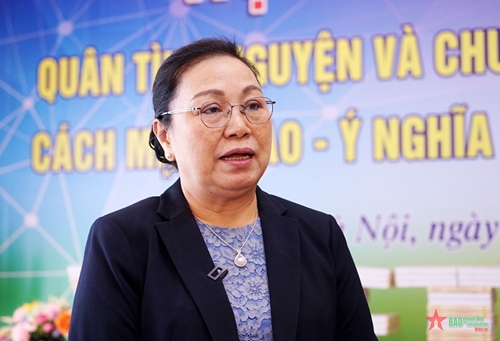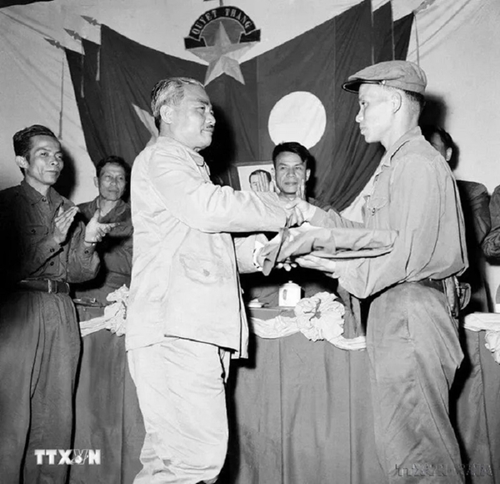Vietnam and Laos are two neighboring countries with shared border and a long history of relations. Since the mid-20th century, under the leadership of the Communist Party of Indochina, later the Communist Party of Vietnam and the Lao People’s Revolutionary Party, the relationship between Vietnam and Laos has flourished under the joint effort and dedication of President Ho Chi Minh, President Kaysone Phomvihane, and generations of leaders and people of the two countries. As a result, the bilateral relation has grown into a great friendship, special solidarity, and comprehensive cooperation. This relationship, now the priceless asset to both nations, has played a crucial role in each country’s revolutionary successes and represents a shared development path for both Vietnam and Laos. The unity and military alliance forged by Vietnam and Laos in the struggle against common enemies stand as a profound testament to the value of this exceptional relationship.
    |
 |
|
General Vo Nguyen Giap and Prince Souphanouvong discussing a joint plan for the Upper Laos campaign in 1953 (File photo) |
Fate brought the two peoples closer together
In 1945, shortly after both Laos and Vietnam gained independence, they faced the return of the French colonial forces. To safeguard the revolutionary achievements of each nation and to foster a united, combat alliance, the governments of Laos and Vietnam signed the Laos-Vietnam Mutual Assistance Treaty on October 16, 1945, and the Agreement on the Organization of the Laos-Vietnam Joint Forces on October 30, 1945.
Based on these agreements, Vietnam deployed military force to assist the Lao revolution. Starting from 1949, Party committees were established across different regions of Laos to oversee the support for the Lao revolution. Vietnamese military forces were organized according to their own system under the name of "volunteer soldiers." From 1950, these Vietnamese volunteer soldiers in Laos were gradually organized into regimental-sized units under the leadership of the Lao resistance government, adhering to the political and military directives of the Lao revolution. In Middle Laos, Unit 280 was established, while in Upper Laos, Units 80, 81, 82, and 83 were set up.
During the resistance war against the French colonialists, the continuous and widespread military operations conducted by the Lao-Vietnamese allied forces significantly expanded liberated zones, forcing the French to adopt a defensive stance on the Indochina battlefield. Notably, the allied forces’ victories in various campaigns across Upper, Middle, and Lower Laos in 1953-1954 created favorable conditions for Vietnamese revolutionary forces to achieve decisive victory at Dien Bien Phu in 1954. This victory compelled the French to sign the Geneva Accords, officially recognizing the independence, sovereignty, and territorial integrity of the three Indochinese nations.
    |
 |
|
Lao Ambassador to Vietnam Khamphao Ernthavanh |
During the resistance war against U.S. imperialism, at Laos’ request and in response to evolving circumstances, Vietnam’s support shifted from military advisory roles to a combination of military advisors and volunteer soldiers. From 1954 to 1958, Vietnam dispatched a delegation of 100 military advisors to assist the Lao revolution in establishing and safeguarding bases, strengthening armed forces, and expanding liberated areas.
Helping neighboring people is helping ourselves
Following President Ho Chi Minh’s teaching, “Helping neighboring people means helping ourselves,” Vietnamese volunteer soldiers and military advisors spared no hardships and sacrifices in their wholehearted support to the Lao military and people. Acting in a spirit of profound international solidarity, they respected the independence, sovereignty, customs, and traditions of the Lao ethnic communities, while providing dedicated and selfless assistance.
Vietnamese volunteer soldiers and military advisors not only directly coordinated combat efforts to help the Lao revolution drive out invaders and their collaborators, but also took part in developing the armed forces, building and strengthening the people’s government, and advancing economic and cultural growth. They helped establish and expand a network of revolutionary bases throughout Laos. This comprehensive support enabled the Lao revolutionary movement to increasingly grow robust, ultimately achieving national liberation in 1975.
From 1976 to 1989, in accordance with agreements and treaties signed between the two governments and defense ministries on military and defense cooperation, Vietnam continued to send military advisors and volunteer soldiers to assist Laos in building its forces and establishing a whole-people defense posture. The Vietnamese force worked alongside Lao forces to thwart counter-revolutionary plots and subversive efforts by hostile forces, thereby firmly safeguarding the people's government and the democratic political system in Laos.
Standing shoulder to shoulder in fight against common enemy
Over 30 years of warfare (1945-1975) and in the first decade of building and defending the people’s democratic political system (1976-1989), the Vietnam People’s Army stood shoulder to shoulder with the Lao military and people, achieving great victories on the battlefield, thwarting the enemy's warfare tactics and subversive schemes against the revolutionary government, and moving forward to complete victory.
The Laos-Vietnam combat alliance is a shining symbol of pure solidarity, unwavering cooperation, and international relations. Vietnamese volunteer soldiers and military advisors in Laos have successfully completed their mission of assisting the Lao revolution, contributing to consolidating and strengthening the great friendship, special solidarity, and comprehensive cooperation between Laos and Vietnam, as the leaders of the Lao Party, State, and people have affirmed: "In Laos, there is no place without the footprints of Vietnamese volunteer soldiers, no victory without the sacrifices and contribution of Vietnamese volunteer soldiers."
    |
 |
|
Prince Souphanouvong presenting two Liberation Orders to the Vietnamese Volunteer Unit on the Western Front (File photo) |
In recognition of the contribution, the Lao Party, State, and People's Army have bestowed numerous high-ranking awards upon the collectives and individuals of the Vietnamese volunteer soldiers and military advisors who have fought and worked in Laos. The Lao people have shown great trust and affection for the volunteer soldiers and military advisors, considering them as their family members.
Currently, hostile forces are intensifying their activities to sabotage the revolutions in both Laos and Vietnam, especially by attempting to sow discord between the two nations and distort the special combat alliance between Laos and Vietnam. To strengthen and deepen the great friendship, special solidarity, and comprehensive cooperation between Laos and Vietnam, and to promote military and defense cooperation between the two states and armies to a new height, we need to intensify information dissemination and education about the tradition of solidarity and combat alliance between the two countries throughout history. Simultaneously, we should promote research and summarize historical lessons to promote the special solidarity and combat alliance between the Party, State, people, and militaries of Laos and Vietnam.
By Lao Ambassador to Vietnam Khamphao Ernthavanh
Translated by Trung Thanh